The Zenana Enclosure is a fascinating architectural complex located in Hampi, Karnataka, India. It served as the secluded quarters for the royal women of the Vijayanagara Empire. This enclosure, also known as the “Harem (Antahpura) Enclosure” offers a glimpse into the lives of the women who resided within its walls and provides valuable insights into the social and cultural dynamics of the era.
The Zenana Enclosure is situated in the northeastern part of Hampi. It’s easily accessible within the Hampi ruins, located close to the Kamalapur Bus Stand, around 2 kilometer away, and around 3 kilometers from the Hampi Bus Stand. You can reach it by walking, hiring an autorickshaw, or renting a bicycle.
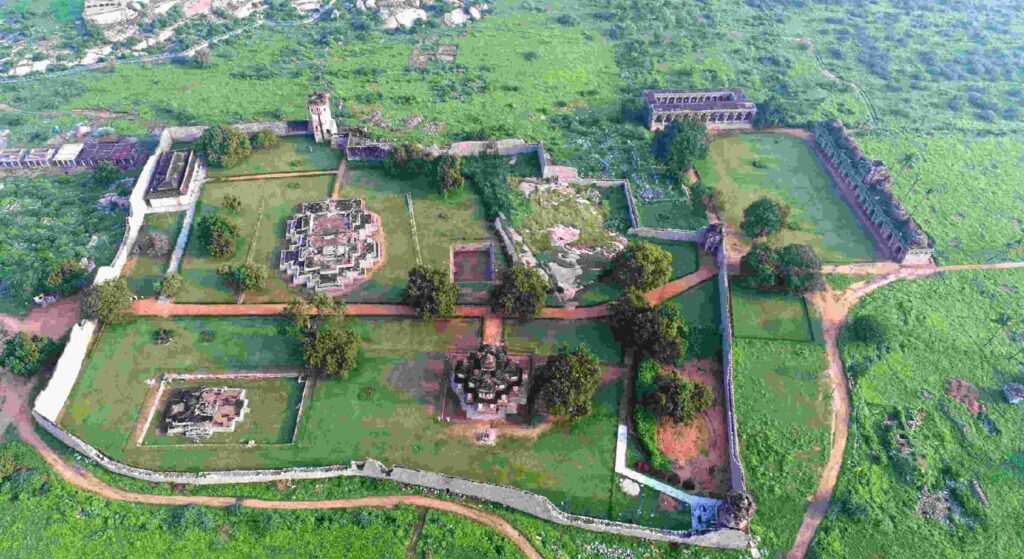
Table of Contents:-
- Quick Facts
- Purpose of the Zenana Enclosure
- Exploring the Zenana Enclosure
- Key Structures in Zenana Enclosure
- Lotus Mahal
- Watch Towers
- Jal Mahal
- Treasury Building
- Exhibition Gallery
- Basement of Queen’s Palace
- Elephant’s Stable
- Guards’ House
- Sculpture Gallery
- Entrance Fees
- Tips for Visitors
- Gallery
- References
Visiting the Zenana Enclosure in Hampi is like stepping back in time and immersing yourself in the rich history of the Vijayanagara Empire. It offers a unique perspective on the lives of the royal women, their experiences, and their contributions to the empire’s cultural and social fabric. Exploring this enigmatic enclosure is an opportunity to delve deeper into the bygone era and appreciate the architectural marvels that stand as a testament to a glorious past.
Quick Facts
- Timing: 08:00 AM to 06:00 PM
- Entry Fee: Entry fee required
- Photography: Allowed
- Location: Google Maps
- Key Structures
The Purpose of the Zenana Enclosure
The Zenana Enclosure served as a private and secure space for the royal women during the 15th and 16th centuries. It was a special area reserved exclusively for the women, eunuchs, and trusted female attendants of the royal household. Here, away from the public eye, the women could engage in leisure activities, religious rituals, and social interactions with each other. This secluded enclosure provided the royal women with a sense of privacy and security, allowing them to lead their lives away from the hustle and bustle of the outside world. Within its confines, they could enjoy moments of relaxation and camaraderie without any interference.
The Zenana Enclosure was an essential part of the palace complex, designed to cater to the specific needs of the women of the royal household. Its architecture and layout reflect the care taken to ensure the comfort and well-being of its inhabitants, making it a fascinating glimpse into the lives of the royal women of Hampi. While there is no direct historical evidence linking this enclosure with the women of the Court, it is widely believed to have served as a sanctuary for them.[1]
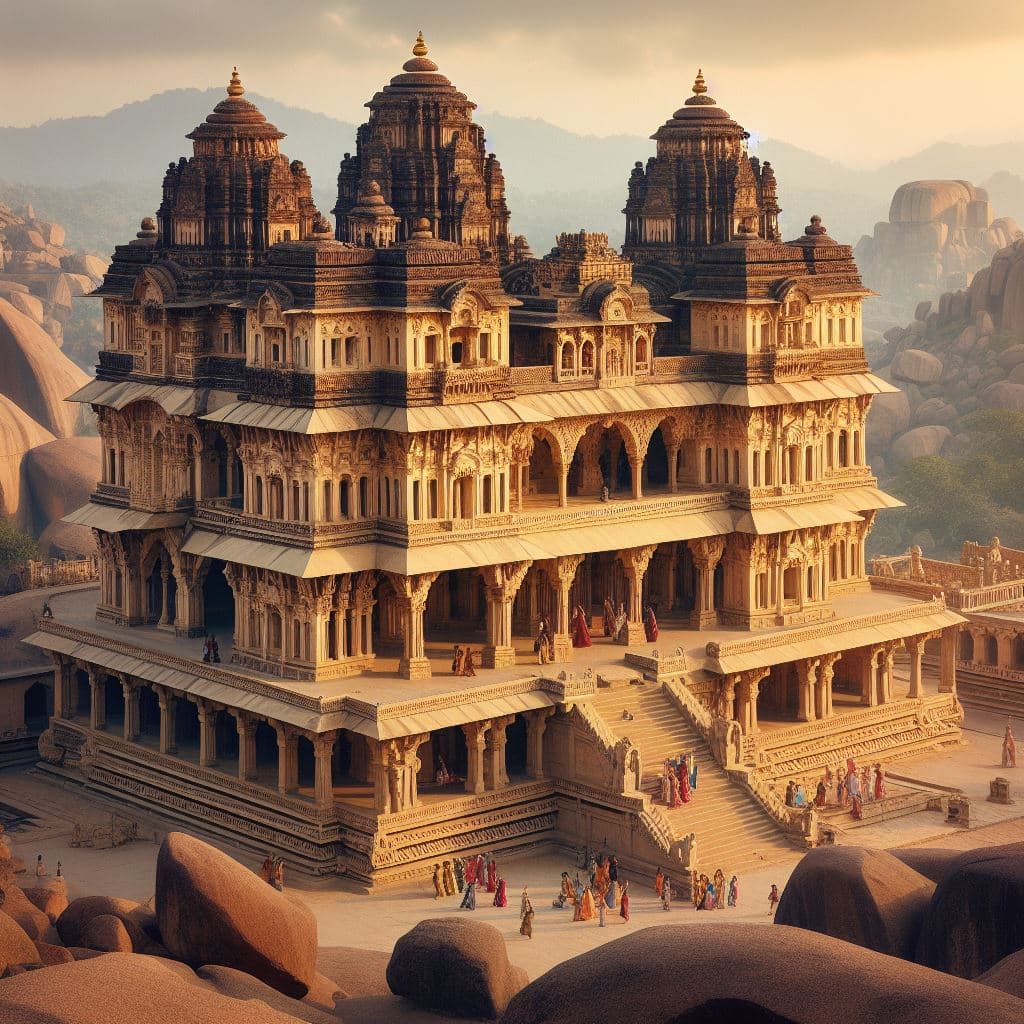
Exploring the Zenana Enclosure
As you explore the Zenana Enclosure, you can imagine the lives of the women who once resided within its walls. The architectural splendor and the intricate carvings on the structures are a testament to the opulence and grandeur of the Vijayanagara Empire. Walking through the corridors and open spaces, you can almost sense the whispers of history and the stories of the women who lived in this secluded world.
The Zenana Enclosure is a complex of structures surrounded by tall walls, with small openings for entry located on the east, west, and north walls. While these openings have been rebuilt over time, the entrances at the north and south walls are the main access points today.
The Zenana Enclosure showcases a fascinating blend of architectural styles. While the dominant architectural style of Hampi leans towards the traditional Dravidian, the Zenana Enclosure exhibits influences from both Hindu and Islamic architecture. This unique fusion reflects the cultural and artistic diversity of the Vijayanagara Empire. Imagine ornately carved pillars reminiscent of Hindu temples, spacious courtyards perfect for social gatherings, and intricately designed windows with hints of Islamic geometric patterns, all contributing to the grandeur of this royal women’s quarters.
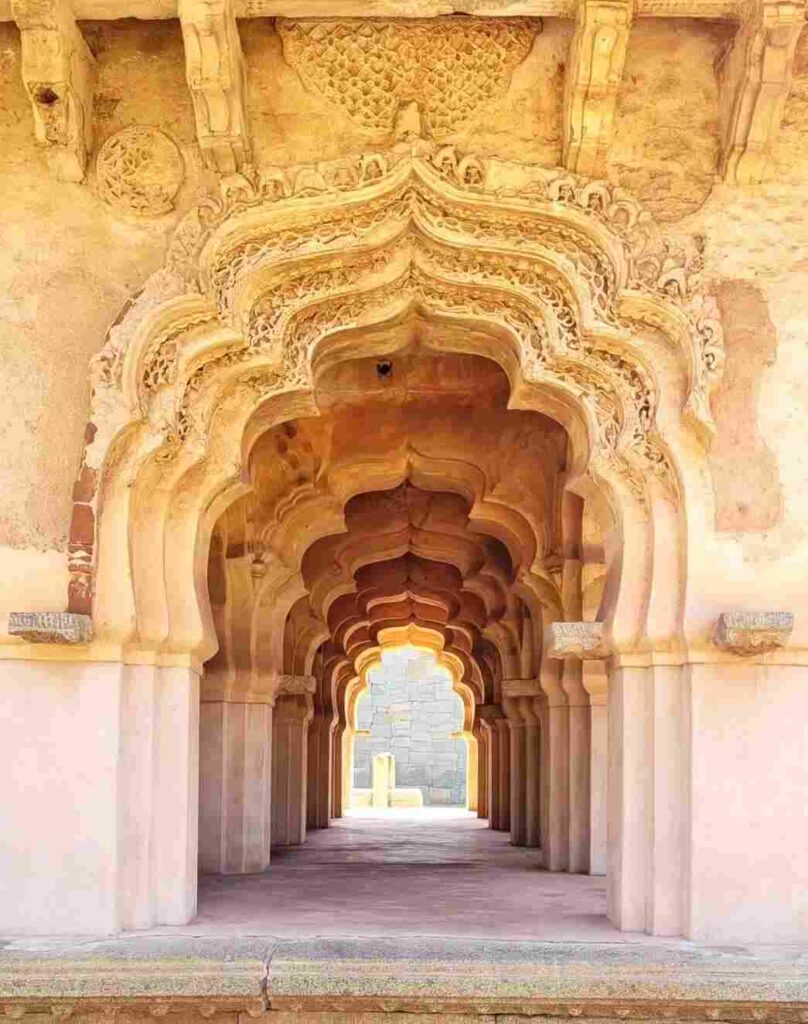
Key Structures in Zenana Enclosure
The Zenana Enclosure is a testament to the architectural ingenuity of the Vijayanagara Empire, boasting an array of remarkable structures. Within this enclosure lie several key monuments that epitomize the empire’s grandeur and artistic finesse. Let’s delve into the notable structures nestled within this historic complex:
- Lotus Mahal
- Watch Towers
- Jal Mahal
- Treasury Building
- Exhibition Gallery in Treasury Building
- Basement of Queen’s Palace
- Elephant’s Stable
- Guards’ House
- Sculpture Gallery in Guards’ House
Lotus Mahal
The Lotus Mahal, also known as Chitrangi Mahal, is a magnificent two-storeyed structure that epitomizes the Indo-Islamic style of architecture. Its offers a glimpse into the royal life of the era, serving as a cool retreat and a haven for leisure activities enjoyed by the women of the royal household. Standing on an ornate stone plinth, it boasts a square plan with projections and recessions in each cardinal direction.

The ground floor features an open pavilion supported by twenty-four square pillars adorned with recessed and foliated arches, while a vaulted ceiling adds to its grandeur. At the center of the ceiling is a plain flat coffered section adorned with a lotus bud. Accessed via a staircase on the north side, the upper storey showcases a series of balconies with windows adorned with recessed and foliated arches. Its ceiling combines vaulted and flat-roofed sections, with the central part featuring an intricately decorated clerestory adorned with stucco arches, friezes, pushpa-podigai (flowerbud corbels), and niches with remnants of seated figures.
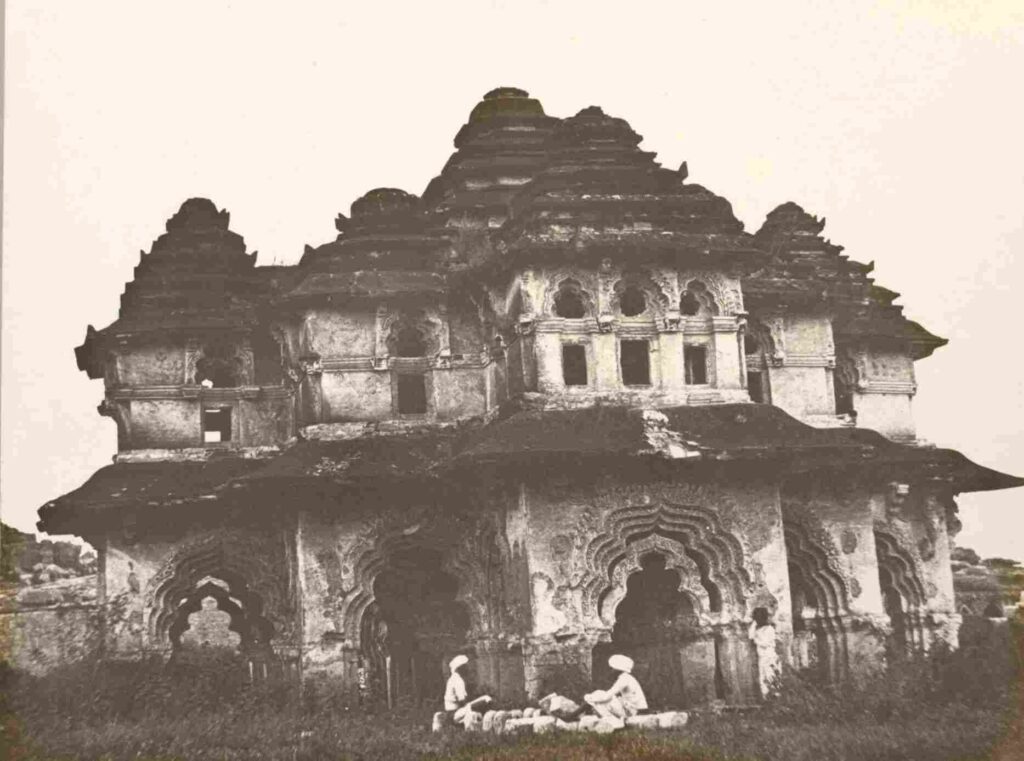
The upper storey culminates in a small ornate ribbed inverted lotus dome, while the superstructure boasts nine pyramidal towers of varying sizes. The exterior of the first storey is lavishly decorated with plaster and stucco ornamentation, including medallions, scrollwork, and simhamukha decorations. The cornice of the first storey is supported by ornate curved brackets, originally upheld by large rampant yalis, of which a damaged one remains on the east side. When fully ornamented with plasterwork and paint, the Lotus Mahal must have been a truly imposing sight, reflecting the pinnacle of architectural splendor of its time.[2]
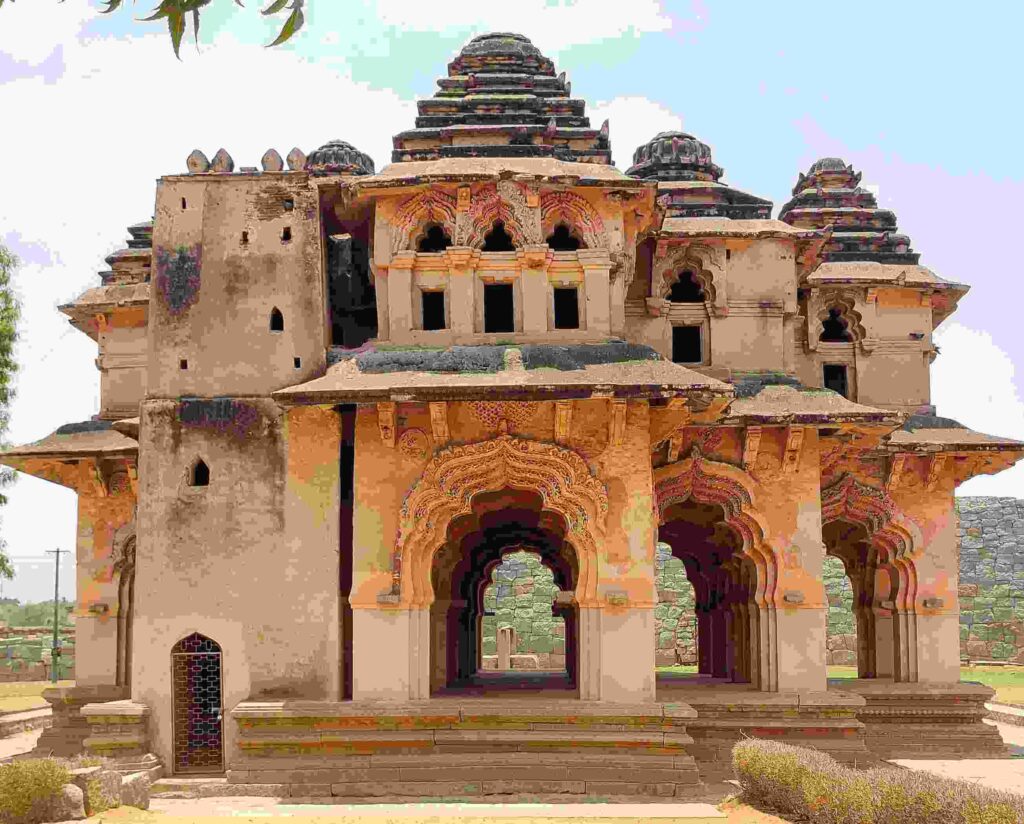
Watch Towers
Within the Zenana Enclosure, three imposing Watch Towers stand as guardians in the Indo-Islamic architectural style. These towers are strategically positioned along the enclosure walls, constructed with irregular yet tightly fitted blocks that taper in thickness as they rise.

The first tower, octagonal in shape, resides in the southeast corner of the enclosure. It boasts three levels and offers commanding views over the approaches to the Royal Centre, providing a crucial vantage point for surveillance and defense. The second tower, square in design, stands proudly in the extreme northwest of the enclosure, serving as another pivotal lookout post.
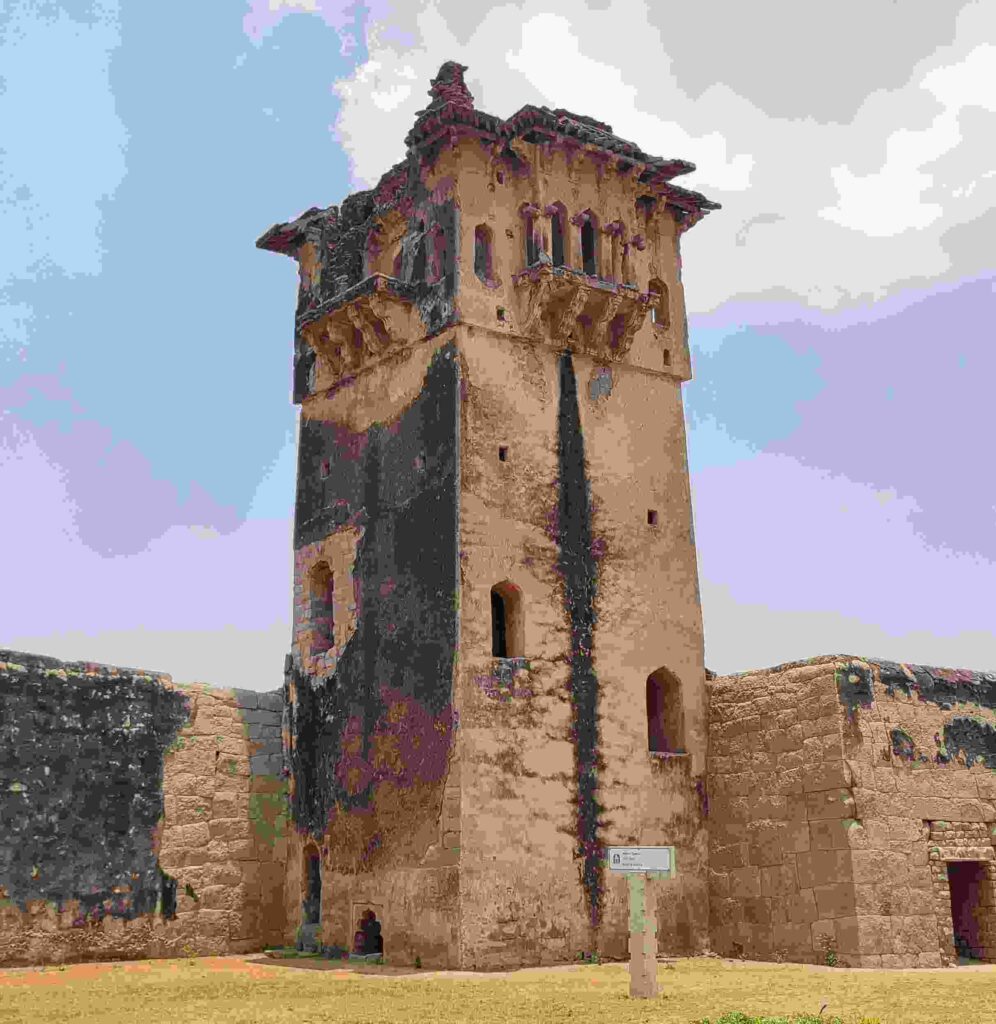
Lastly, a square tower, though now in ruins, occupies the extreme northeast corner of the enclosure, reminding visitors of its once formidable presence. Despite its current state, it remains a testament to the defensive fortifications of the Vijayanagara Empire and adds to the allure of the Zenana Enclosure’s historical landscape.
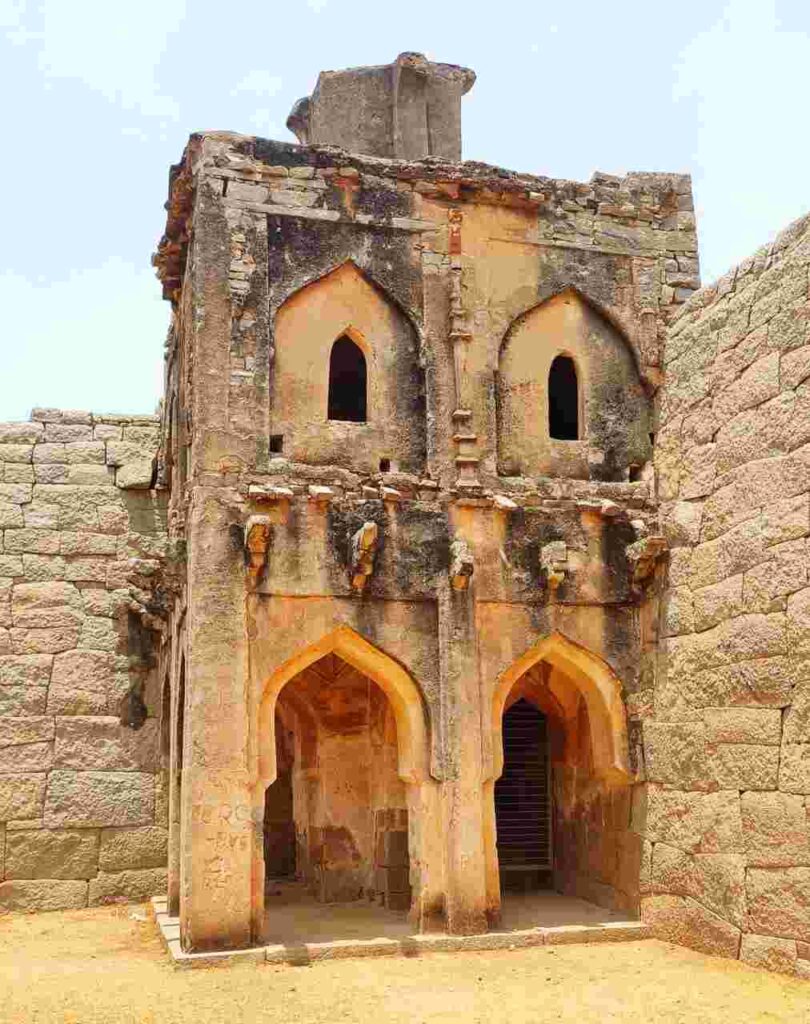
While some towers in ruins, their presence speaks volumes about the importance the Vijayanagara rulers placed on security and the beauty they incorporated even into functional structures. These towers not only served as defensive bastions but also showcased the empire’s architectural prowess and attention to detail.[3]
Jal Mahal
The Jal Mahal, also known as the Water Pavilion, is a captivating structure set within a rectangular tank, offering a serene oasis within the Zenana Enclosure. The central structure, facing east, is accessible via a bridge located at the southern end. Characterized by projections and recessions, it spans two levels.
The steps on the eastern side descend into the tranquil waters, while the second level, defined by a series of mouldings and traces of plaster flooring, provides a glimpse into its former grandeur. Carvings of fish and boats adorn the basement of the central structure, hinting at its aquatic theme. The tank itself is entered through flights of steps located at the east and south sides and features pavilions at its corners. Remnants of the bridge and pavilions still stand, serving as poignant reminders of its past splendor.
It is believed that this structure may have served as a summer residence for the royals, providing a cool retreat during the scorching summers of Vijayanagara.[4]

Treasury Building
Located in the northwest corner of the Zenana Enclosure, the Treasury Building, also known as the Hall of Exercise or Guards’ House, stands as a testament to the strength and solidity of Vijayanagara architecture. Despite being variously identified, its robust masonry construction and limited openings, comprising only a small doorway and a series of ventilation holes, suggest its purpose as a storeroom or treasury.
Accessed from the east through a pointed arched doorway set within a rectangular recess, the interior reveals a large rectangular space at its center, surrounded by a raised pillared corridor on all four sides. The central rectangle features a vaulted ceiling formed of foliated arches springing from the tops of the corridor pillars. Twenty-four columns divide the corridor into several sections, each adorned with plain vaulted ceilings and octagonal domes.
The exterior walls of the structure are plain, with the eaves supported by corbels, horizontal beams, and rafters embellished with plaster snakehoods. Above the eaves, a brick and plaster parapet showcases interlocked pointed arch and petal patterns, adding to the building’s aesthetic appeal. This imposing structure not only served practical functions but also exemplifies the architectural sophistication of the Vijayanagara Empire.[5]
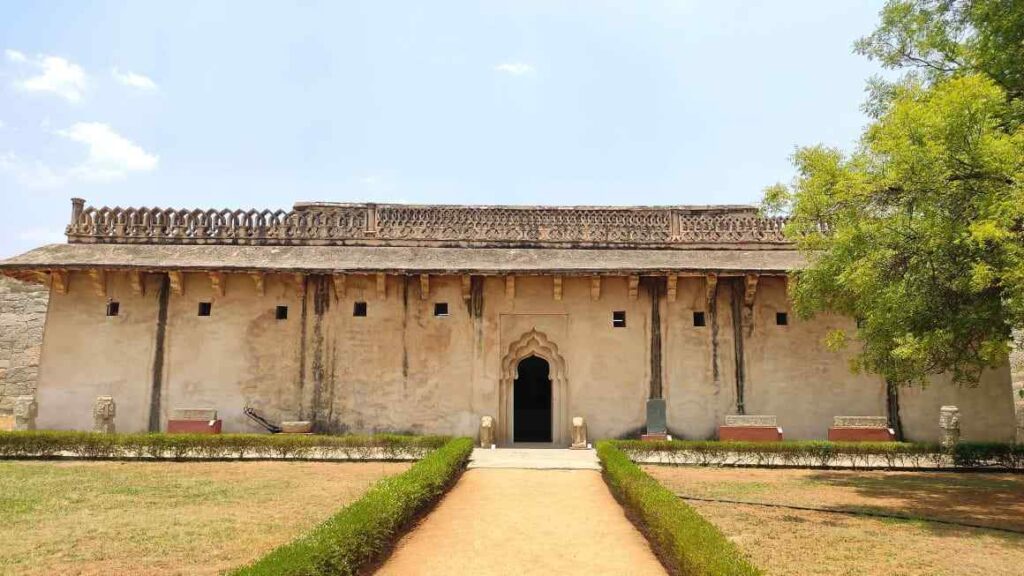
Exhibition Gallery in Treasury Building
The Treasury Building within the Royal Centre now houses an exhibition gallery curated by the Archaeological Survey of India, showcasing a wealth of antiquities excavated from Hampi and its surrounding areas since 1976.[6]
Inside the gallery, visitors can marvel at a diverse collection of artifacts spanning various historical periods. From Pre and Protohistoric antiquities to Buddhist panels from the pre-Vijayanagara era, Jaina, Shaiva, Vaishnava, and Shakta sculptures, the exhibition offers a glimpse into the rich cultural heritage of the region.
Notable highlights include a sculpture of the goddess Bhuvaneshvari from Vira Harihara’s palace and a Buddhist panel dating back to the 1st or 2nd century CE. Visitors can also view a pillar inscription documenting the history of Vira Harihara’s palace. In addition to sculptures, the gallery features an array of other artifacts such as beads, pottery, metal objects, miniature figurines, and stucco figures, providing a comprehensive overview of Hampi’s archaeological significance and cultural evolution.
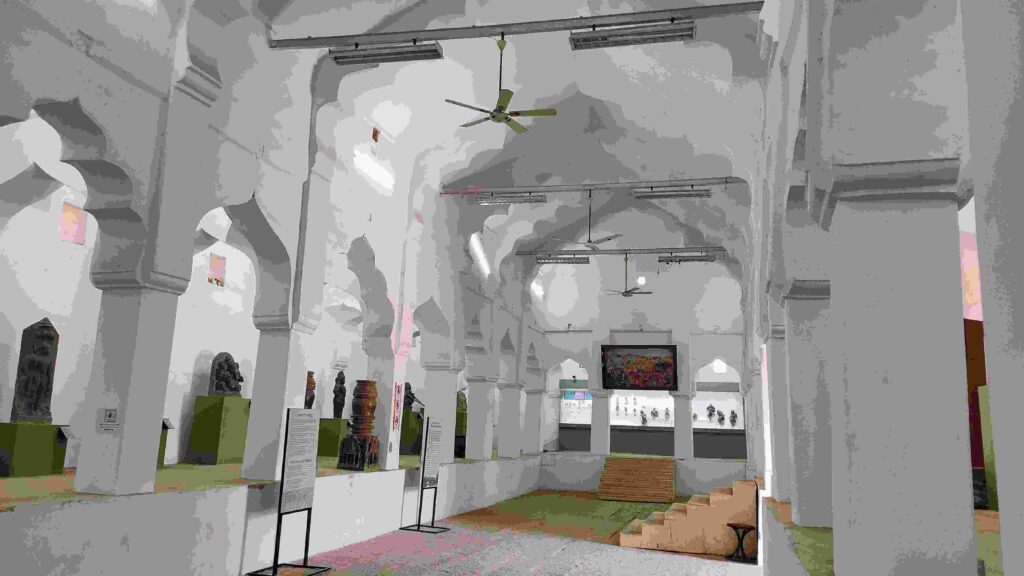
Basement of Queen’s Palace
The ruins of the structure popularly referred to as the Queen’s Palace stand as a testament to the grandeur of Vijayanagara architecture, although there is no definitive archaeological or historical evidence to support this designation.[7] Facing north, the palace is accessed through a flight of steps adorned with elephant balustrades.
The palace structure, characterized by projections and recessions on all sides, boasts three ascending levels, distinguished by a series of ornate basement mouldings. Visitors can ascend to the first two levels via flights of steps located at the center of the north side, which then run continuously around the building, forming a walkway.
Access to the third level is granted by two flights of steps on the sides, where the outlines of four-square chambers are still visible. Despite the lack of concrete evidence regarding its original purpose, the architectural intricacy of the Queen’s Palace basement offers insight into the craftsmanship and ingenuity of its builders.
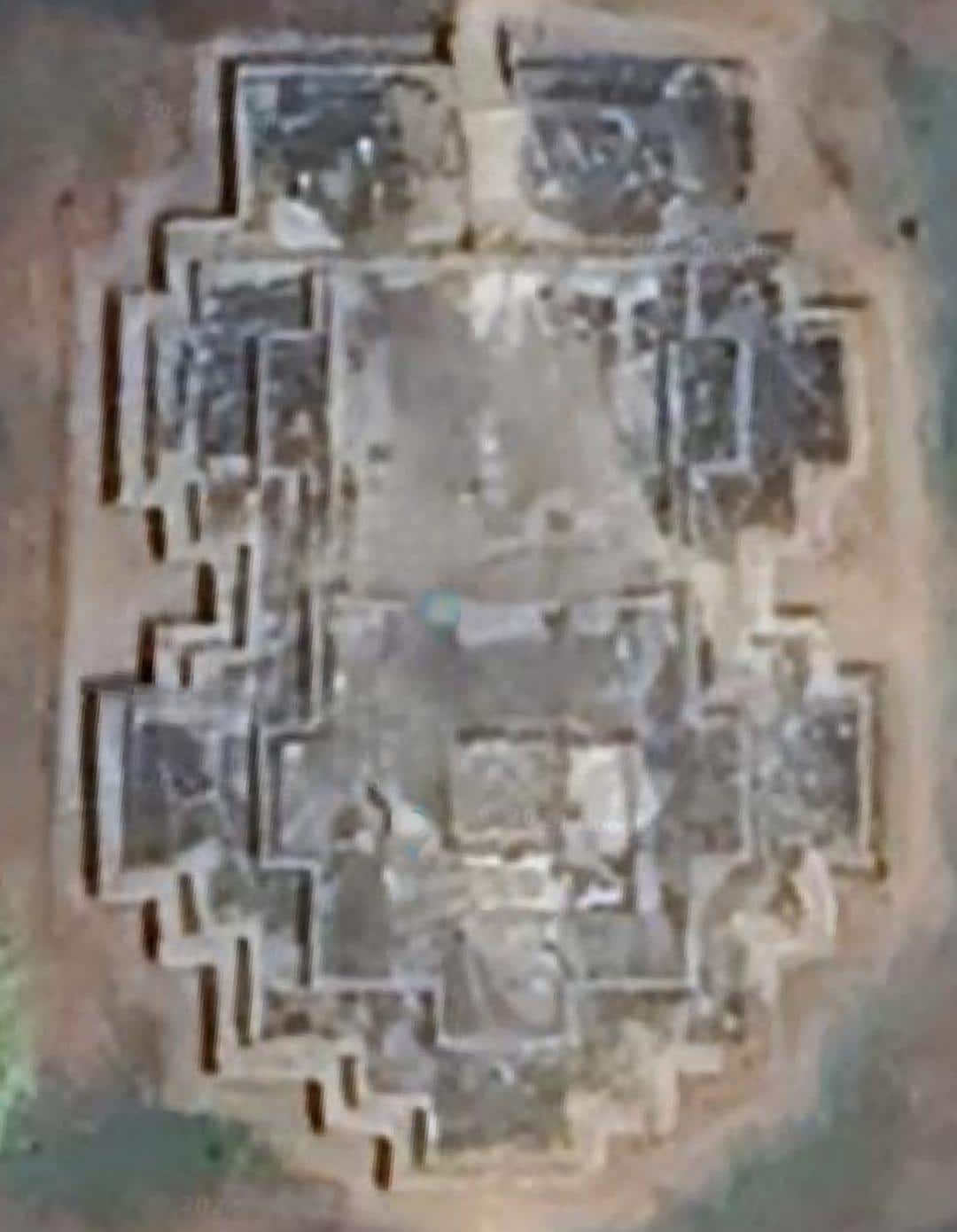
Elephant’s Stable
This remarkable structure, dating back to the 15th century and built in the Indo-Islamic style of architecture, is believed to have served as the stable for the state elephants, although some argue it may have been a palace secretariat.[8] The Elephant’s Stable is a long rectangular building, measuring 85 x 10 meters, and facing west. It comprises eleven large domed chambers, each identical in design.
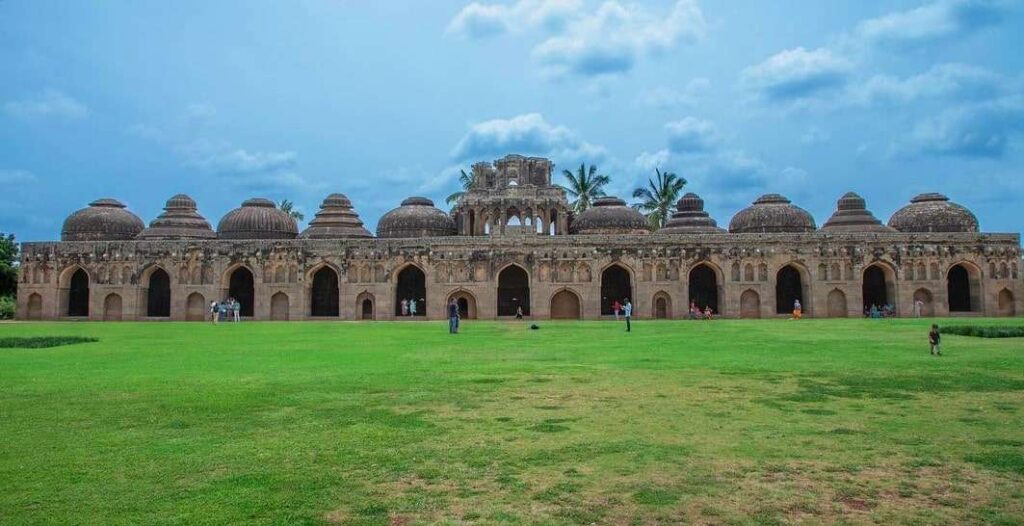
The chambers feature recessed niches on three sides and an arched entrance on the west. Eight of the chambers have small arched openings on the east wall, while three additional arched openings are found on the north and south walls, connecting four chambers each. Between the entrance arches, the exterior showcases small arches topped by three smaller arched arches and miniature recesses with angled tops.

Above the chambers, domes of various types rise symmetrically, including circular, octagonal ribbed, and fluted designs. The central chamber is topped by a ruined two-storeyed structure, accessible via two staircases. Remnants of ornate stucco and plaster ornamentation adorn both the exterior and interior, reflecting the building’s former grandeur and intricate design. Despite its current state, the Elephant’s Stable stands as a testament to the architectural prowess of the Vijayanagara Empire and the significance of elephants in its royal court.
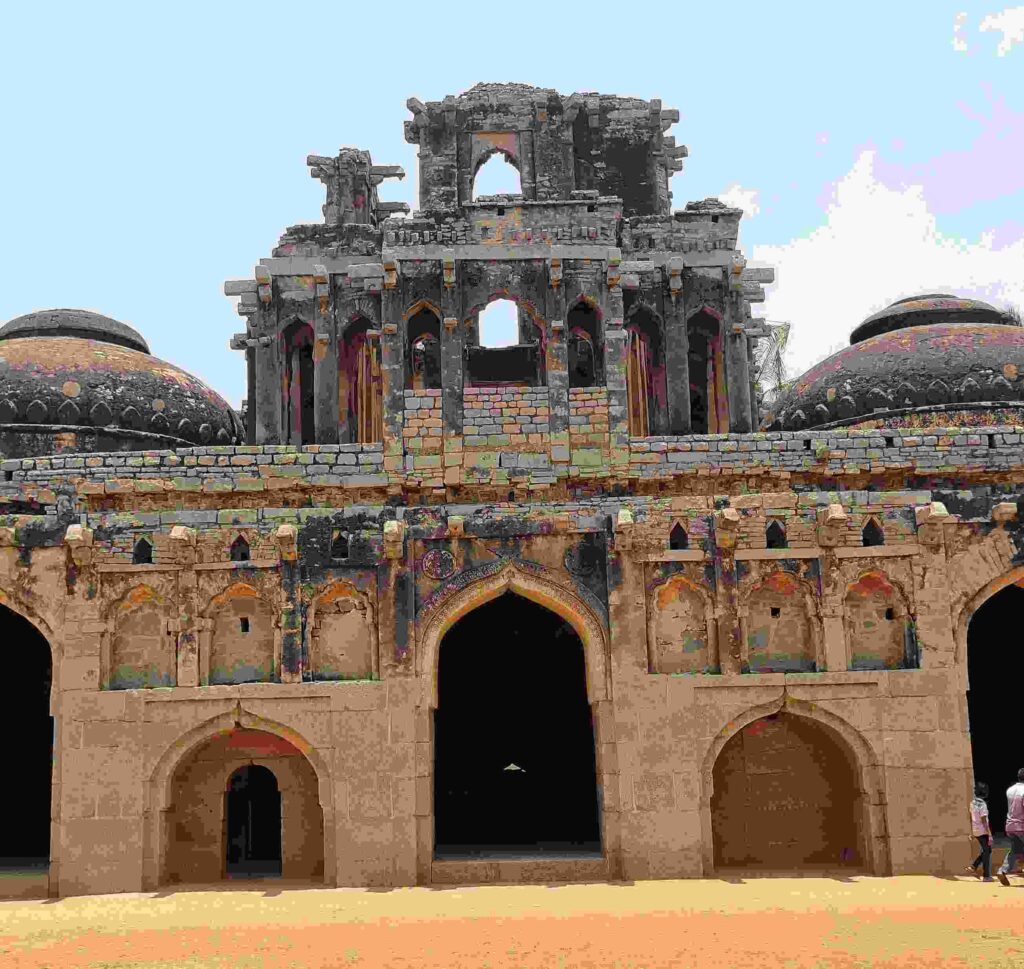
Guards’ House
This imposing structure, located at a right angle to the northern end of the Elephant’s Stable, is commonly known as the Guards’ House, although it has also been referred to as a Concert Hall and a Treasury.[9] This rectangular building measures 42 x 12 meters and faces south.
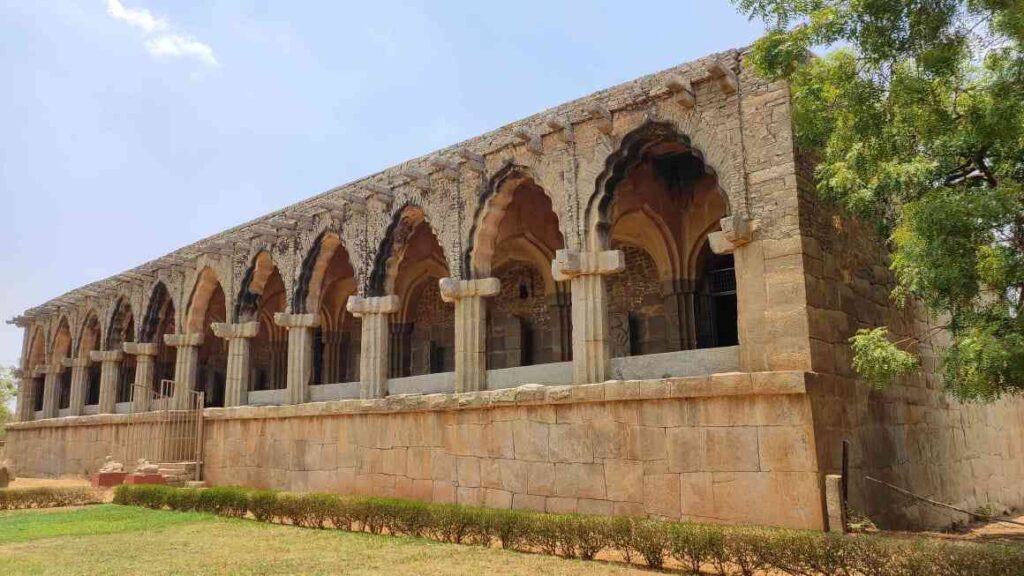
At the front, it features a high verandah with a tall arched entrance flanked by five arches on either side. The rear of the building encloses a rectangular open courtyard with a raised corridor all around. The stone piers supporting the arches are adorned with brackets featuring simple roll mouldings, which once supported stone frames. Although the eave has vanished, corbels above the arches indicate its former presence.
The ceilings are mostly plain, except for the coffered ones in the verandah. To the southwest of the Guards’ House, visitors can observe the ruins of a massive entrance gateway, adding to the historical significance of the site.
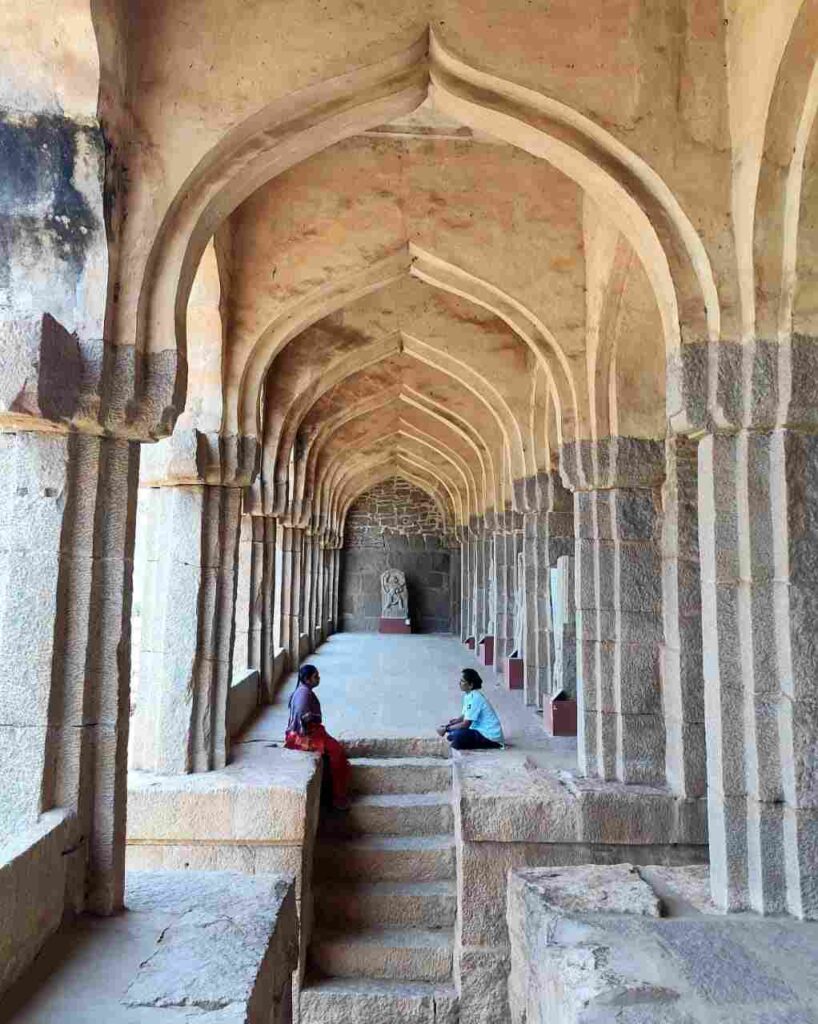
Sculpture Gallery in Guards’ House
The Guards’ House, now home to a sculpture gallery curated by the Archaeological Survey of India, offers a captivating display of ancient artworks. Against the back wall of the verandah, visitors can admire a diverse collection of sculptures representing various deities and mythological figures.[10]
Among the exhibits are sculptures of Shiva, Ganesha, Kalabhairava, Nandi, and Virabhadra, exemplifying Shaiva iconography. Additionally, sculptures of Ananthasayana Vishnu, Lakshmi, and Garuda showcase Vaishnava figures. The gallery also features sculptures of Hanuman, Naga, Nagini, Maha-Sati, Herostones, and Saptamatrikas, providing a comprehensive representation of Hindu mythology and religious beliefs. Some sculptures depict different stages of creation, offering insight into the artistic process, while others are finished masterpieces.
Particularly noteworthy are the sculptures of Ananthasayana Vishnu and Kalabhairava, renowned for their intricate craftsmanship and detailed execution. Among the Herostones and Maha Sati stones, one striking sculpture portrays a hero attaining a heavenly abode through the Sula method of sacrifice, reflecting the rich cultural and religious heritage of the region.

Zenana Enclosure Entrance Fees
Planning a trip to the Zenana Enclosure? Keep in mind there’s a cost to enter the temple grounds. The fee depends on your nationality. For visitors from India and some neighboring countries, the entry fee is quite reasonable. Foreign tourists from other countries will pay a bit more. The good news is that children under 15 get free admission![11]
Entry Fees Based on Nationality:
The entry fee to visit Zenana Enclosure varies depending on your nationality. Indian citizens and visitors from SAARC and BIMSTEC countries enjoy a minimal fee of 40 rupees (35 rupees online). SAARC stands for South Asian Association for Regional Cooperation, and BIMSTEC is the Bay of Bengal Initiative for Multi-Sectoral Technical and Economic Cooperation.
Foreign Tourists Fee:
Foreign tourists from countries outside of SAARC and BIMSTEC are required to pay a fee of 600 rupees (Online 550 rupees) to enter Zenana Enclosure.
Free Entry for Children:
Children under 15 years old are granted free entry to Zenana Enclosure, regardless of their nationality. This allows families to explore the temple complex together without worrying about additional costs for young ones.
Ensuring Compliance:
It’s essential to adhere to the entry fee regulations and provide appropriate identification when purchasing tickets. Visitors should carry valid identification documents such as passports or government-issued IDs to verify their nationality and age.
Online or Offline:
You can purchase the ticket from the ticket counter located in front of the Zenana Enclosure, or you have the option to buy it online to avail of a discount of five rupees and skip the long queue. The ticket is valid for one day only, from sunrise to sunset, and grants access to all monuments at Hampi, including the Archaeological Museum.

Tips for Visiting the Zenana Enclosure
Planning a visit to the Zenana Enclosure in Hampi? Make the most of your trip with these helpful tips. These suggestions will ensure you have a memorable and enjoyable experience exploring this fascinating historical site.
Wear Comfortable Footwear:
The Zenana Enclosure involves walking on uneven terrain, so wear sturdy, closed-toe shoes to navigate the site comfortably.
Bring Sun Protection:
Hampi can get quite hot, especially during the day. Protect yourself from the sun by wearing a hat, sunglasses, and sunscreen.
Stay Hydrated:
Carry plenty of water with you to stay hydrated while exploring the Zenana Enclosure, especially if you’re visiting during the warmer months.
Limited Amenities:
Carry essentials like water and snacks as there are limited shops and restaurants near the Zenana Enclosure.
Plan Your Visit:
Allocate enough time to explore the Zenana Enclosure thoroughly. Consider visiting early in the morning or late in the afternoon to avoid the midday heat and crowds.
Respect the Heritage:
The Zenana Enclosure is a historical site, so please respect the heritage by not climbing on the structures, littering, or defacing the monuments and dispose of waste responsibly.
Learn About the History:
Hire a guide or do some research beforehand to learn about the history and significance of the Zenana Enclosure. Understanding the context will enrich your experience.
Take Your Time:
Don’t rush through the site. Take your time to admire the architectural details, sculptures, and surroundings of the Zenana Enclosure.
Camera:
Capture the architectural beauty and intricate details of the Zenana Enclosure. Be mindful of other visitors while taking photos.
Hampi Exploration:
The Zenana Enclosure is just one part of the vast Hampi ruins complex. Plan your visit to include other captivating sites like the Virupaksha Temple, the Royal Centre, Vittala Temple, and more.
Gallery:-
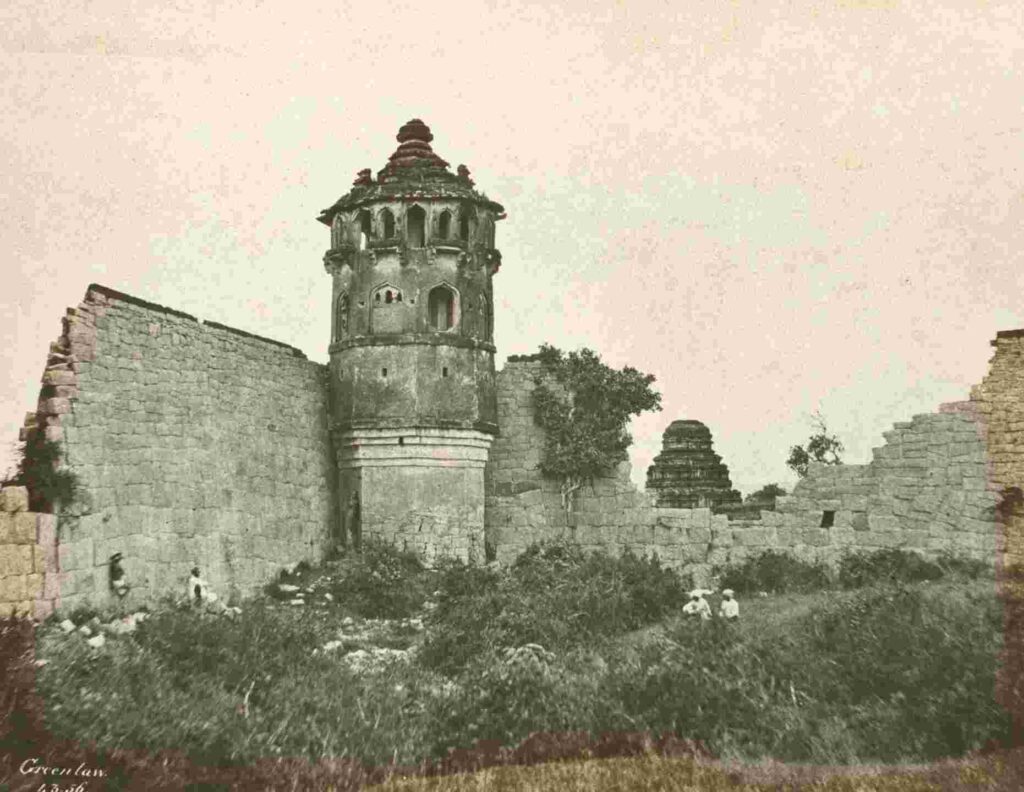
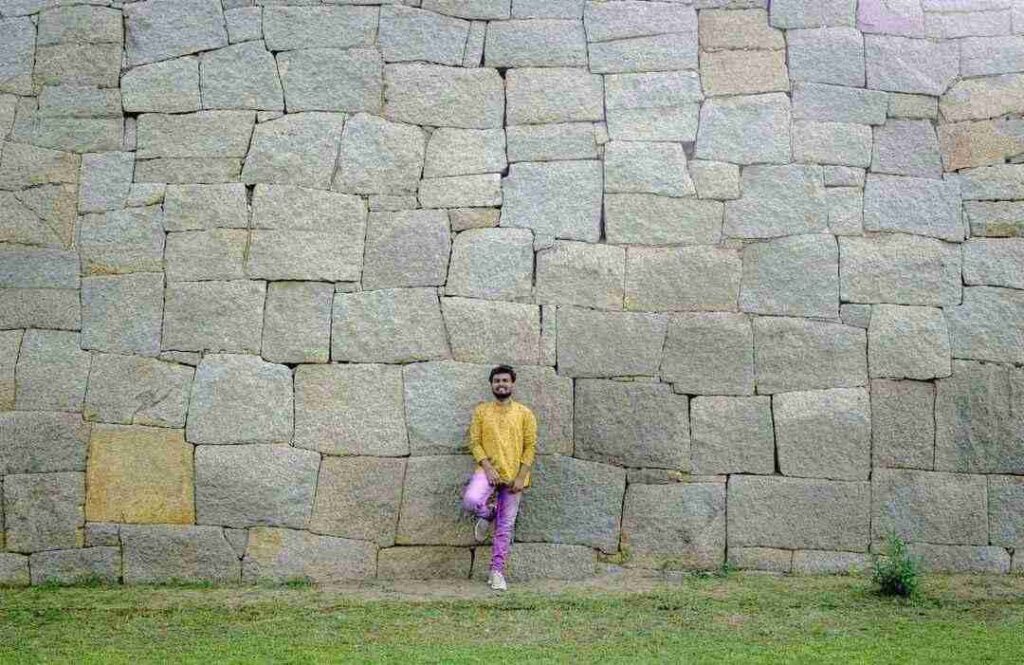
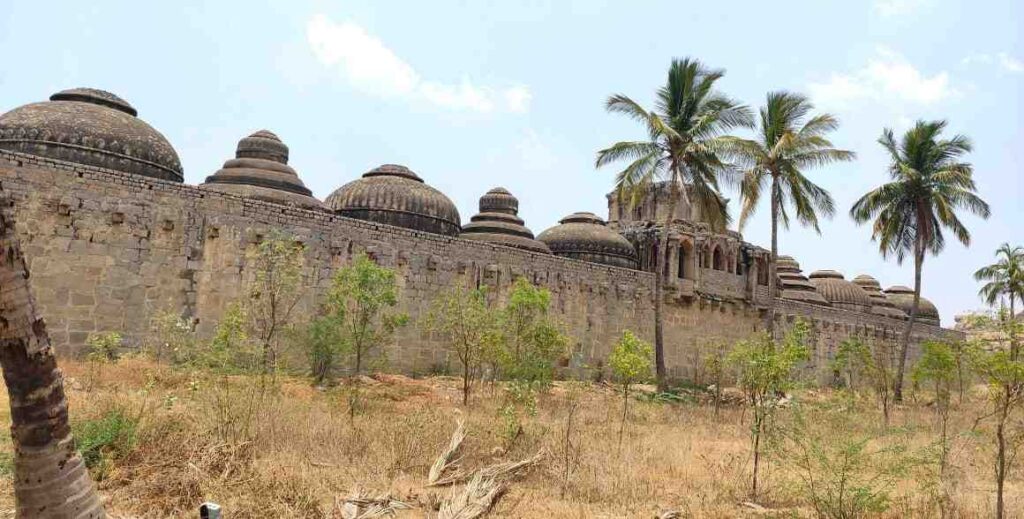
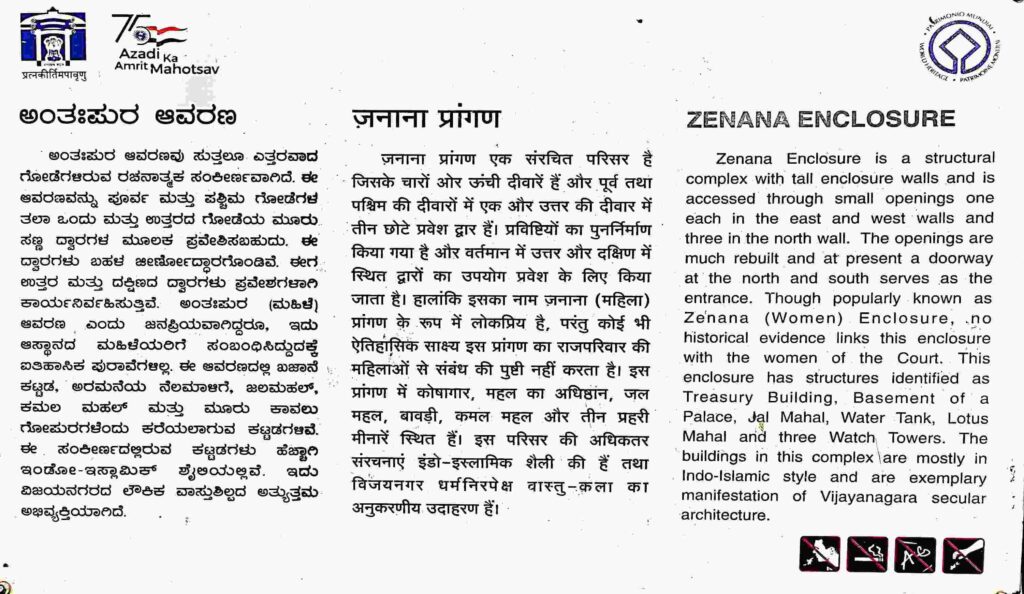
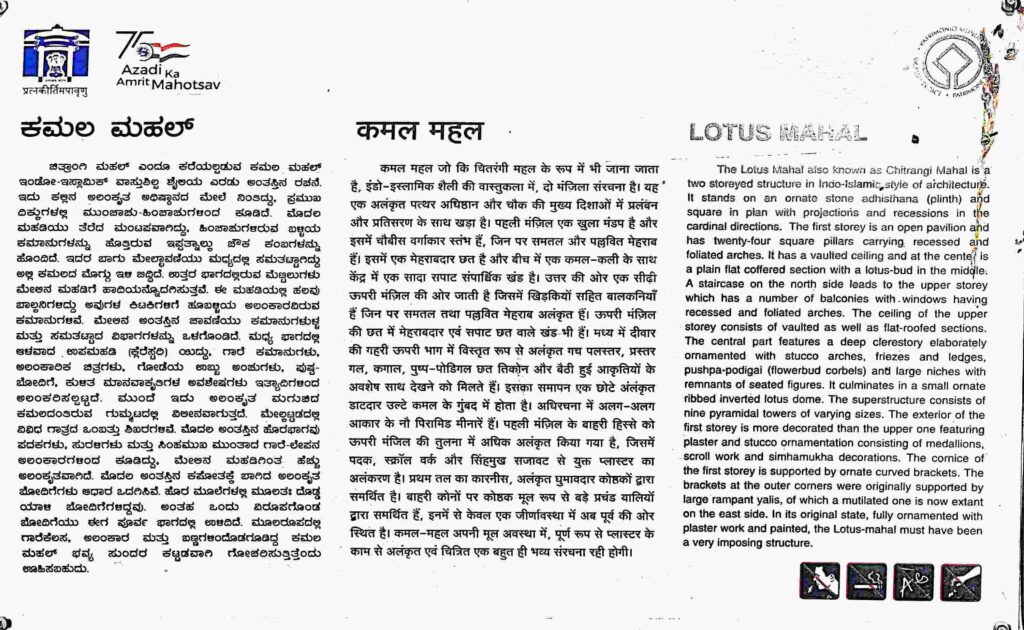
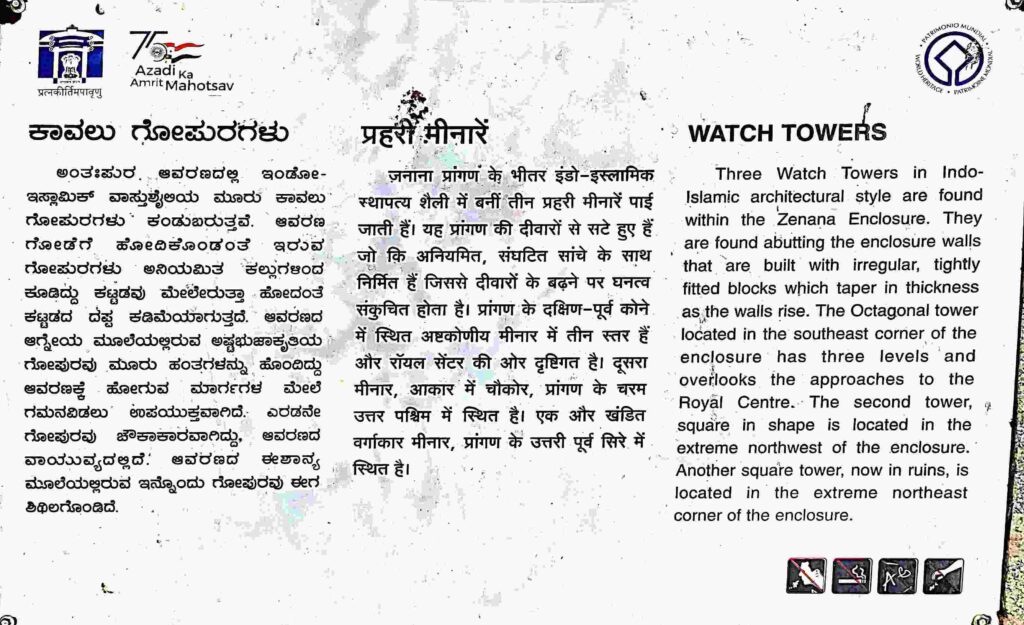

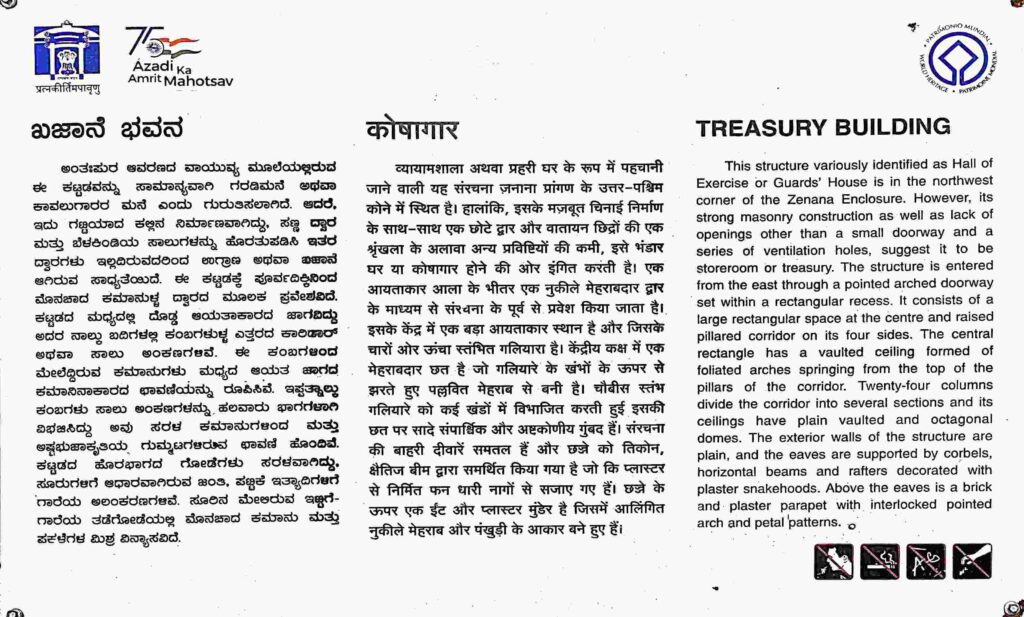
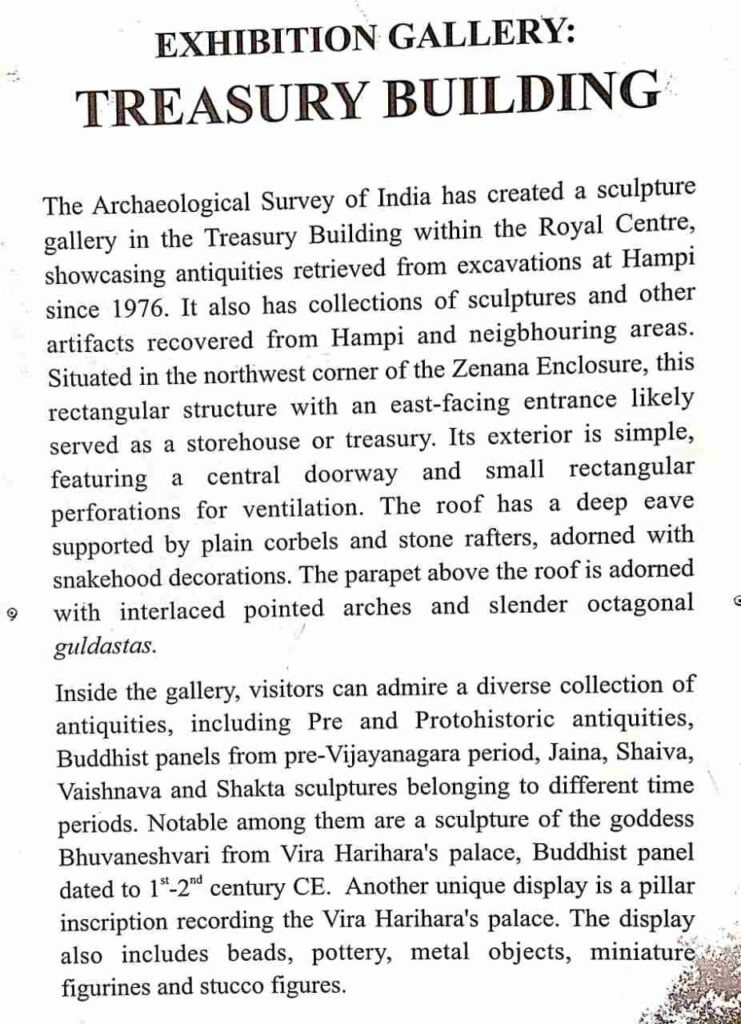
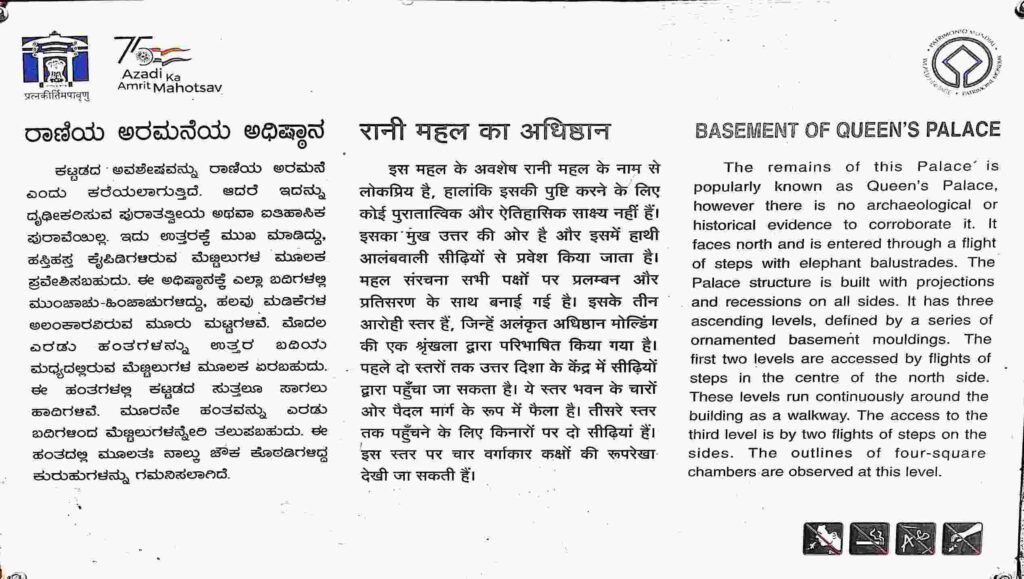
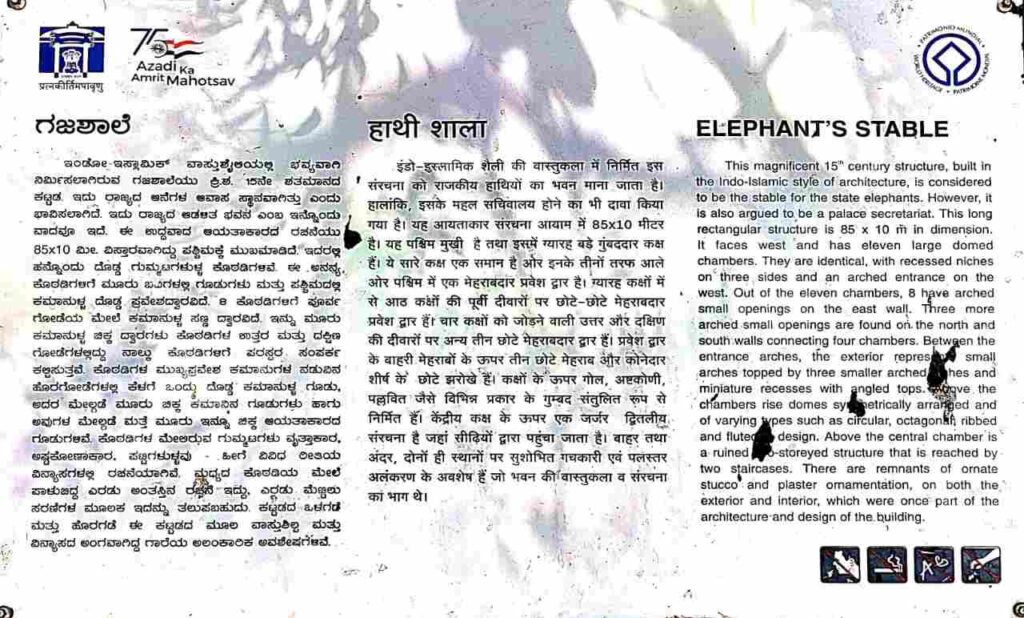

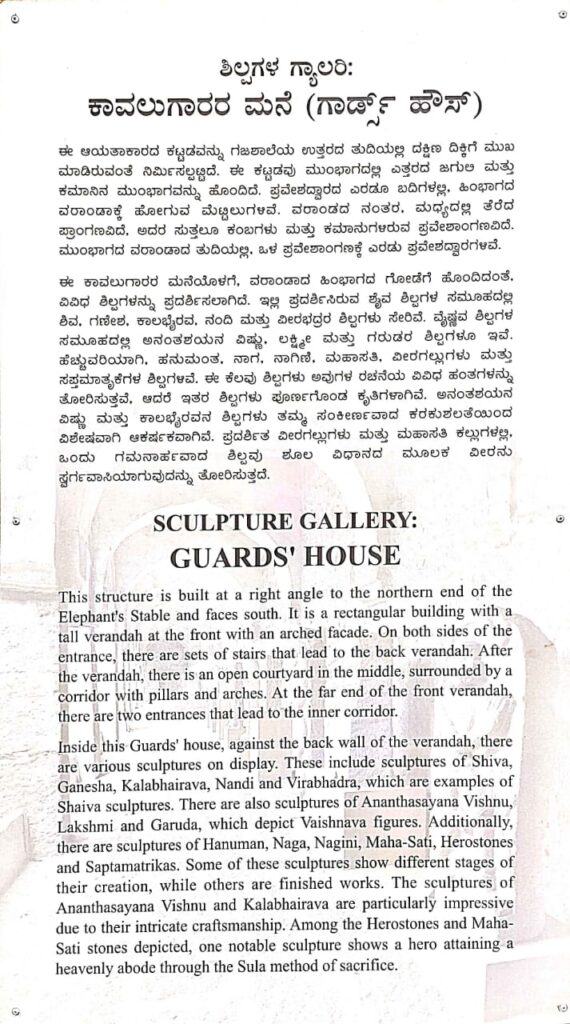
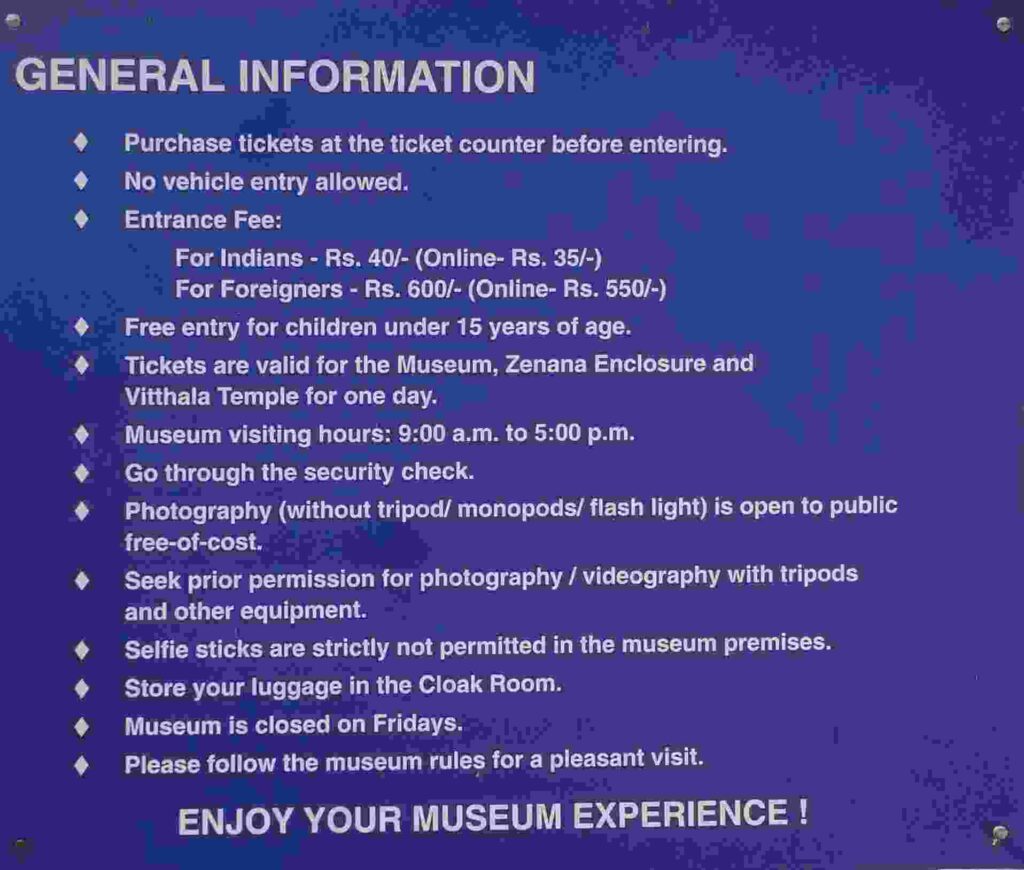
References:-
References from the Following Sources;
- ^[1] – ASI information plaque about Zenana Enclosure
- ^[2] – ASI information plaque about Lotus Mahal
- ^[3] – ASI information plaque about Watch Towers
- ^[4] – ASI information plaque about Jal Mahal
- ^[5] – ASI information plaque about Treasury Building
- ^[6] – ASI information plaque about Exhibition Gallery in Treasury Building
- ^[7] – ASI information plaque about Basement of Queen’s Palace
- ^[8] – ASI information plaque about Elephant’s Stable
- ^[9] – ASI information plaque about Guards’ House
- ^[10] – ASI information plaque about Sculpture Gallery in Guards’ House
- ^[11] – General information board displayed at the entrance of the Hampi-Kamalapur Archaeological Museum